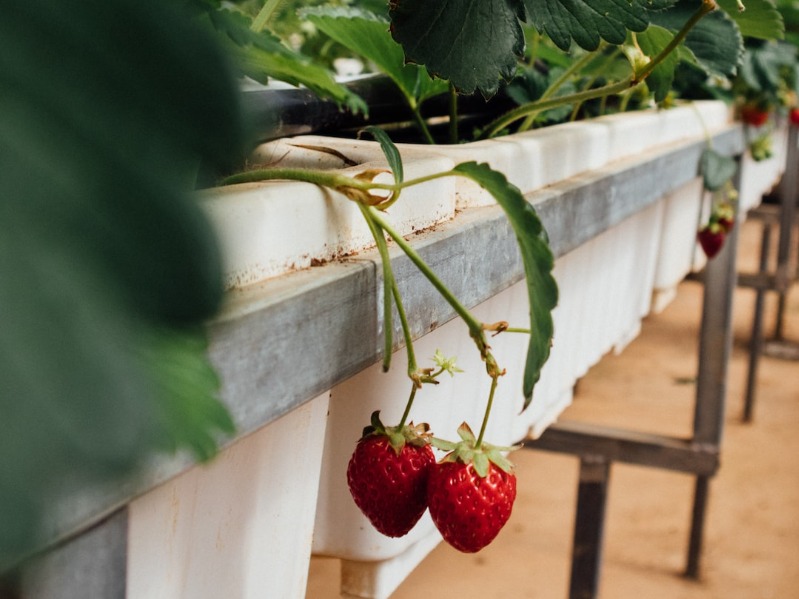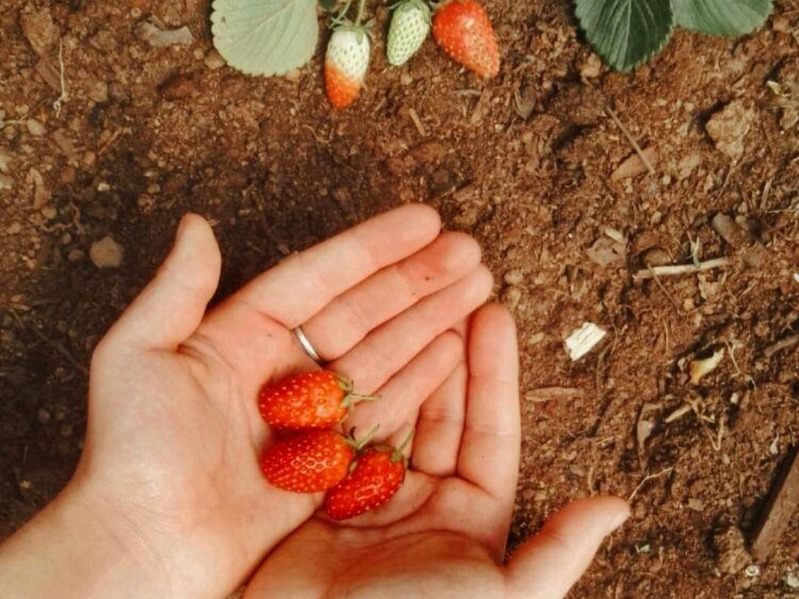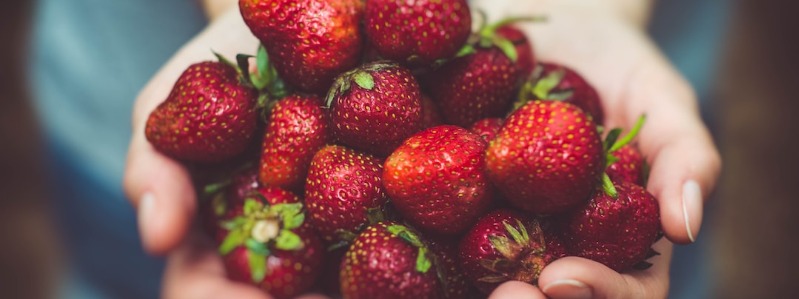Grow Texas Strawberries as an Annual in Special Pots or Raised Beds
Contents
- Grow Texas Strawberries as an Annual in Special Pots or Raised Beds
- Containers for Growing Strawberries
- When to Buy Strawberry Plants
- Some Recommended Strawberry Varieties
- When to grow Strawberries in Texas
- How to Plant Strawberries
- Grow Strawberry Plants Using Natural Fertilizer and Pest Control
- Prepare the Garden to Plant Strawberries
- Organic Strawberry Pest Control
- Using Strawberries
- Final Word
It takes extra care to grow strawberries in Texas though many people believe the result is worth the effort. Select June-bearing varieties and plant them annually.
Texas strawberries grow well in raised beds and are attractive container plants even when they are not producing fruit. Although strawberries are perennial plants in the Northern United States, they are usually treated as annuals in Texas since they do not do well in the sustained summer heat.
Containers for Growing Strawberries
A wide range of bespoke strawberry planters is on the market. The imaginative gardener can design and make his very own planter.
- Terracotta strawberry pots with planting pockets are attractive but need careful watering in summer to avoid letting the plants dry out.
- Pots or wooden half barrels are easy to manage. Choose a pot at least 25cm in diameter and put in no more than three plants.
- Hanging baskets are suitable, but again choose one at least 35cm in diameter or the compost will dry out very quickly.
- Window boxes can be used and take up no ground space at all.
- Sectional tower pots provide suitable growing conditions.
- Tiered plant stands made from timber to hold growing bags are attractive and functional.
- To cut costs the handy D.I.Y. enthusiast can make a raised cradle from rough-sawn timber. Such constructions may be lined with old carpets and filled with compost prior to planting.

When to Buy Strawberry Plants
Pot-grown plants can be bought all year round. Fresh dug bare root plants are usually available from October to November and will give a decent crop the first year after planting. Cold-stored or frozen plants are available from specialist producers from March/April to late July. If planted between May and July they will crop within 60 days provided they are well watered in dry weather.
Some Recommended Strawberry Varieties
Early Varieties (cropping mid-June to early July)
- ‘Honeoye’ carries heavy crops of large bright red berries with good flavor.
- Mid-Season (cropping from late June to mid-July
- ‘Cambridge Favourite’ is a widely grown reliable variety with good flavor.
- ‘Elsanta’ has heavy crops of large, firm berries and is of very good flavor
- ‘Tenira’ has excellent flavor and crops prolifically bearing medium-sized firm, juicy fruits.
Late season (cropping throughout July)
- ‘Symphony’ has good yields of firm, juicy bright red well-flavored berries.
- Perpetual (cropping mid-August to mid-October)
- ‘Mara des Bois’ tastes fantastic and has good-sized berries.
- When to grow Strawberries in Texas
When to grow Strawberries in Texas
Strawberry season in Texas is an exciting time for fruit lovers and gardeners alike. Whether you’re a beginner or an experienced grower, the thought of picking fresh strawberries from your own backyard can be tantalizing. Knowing when to plant is key to successfully cultivating these sweet treats in the Lone Star State.
The optimal growing season for strawberries in Texas begins at the end of February and runs through May. This makes late winter/early spring the ideal time to start planting so that plants are ready to produce ripe fruit as temperatures rise throughout the spring months. It’s also important to select your strawberry variety carefully; June-bearing varieties tend to produce larger yields than ever-bearing varieties, although ever-bearers may give multiple harvests over a long period of time if planted at the right time.
How to Plant Strawberries
Plant annual strawberries in South Texas from late September to the first week of October and in late winter or early spring in North and West Texas. Strawberries may be planted in containers or raised beds. They need sunlight and well-drained soil with lots of nutrient material.
Strawberry plants prefer slightly acidic soil with a pH of 6.0. Chandler, Sequoia, and Douglas are varieties recommended for Texas gardens by Dr. Larry Stein, professor and horticulturist at Texas A&M University writing for Texas Gardener. These June-bearing strawberries are preferred over ever-bearing or day-neutral varieties.

Clear the site of any plant material before preparing your strawberry bed. It is best to select a site that does not have a heavy infestation of perennial weeds since they are difficult to remove completely. Because of possible root diseases that remain in the soil from tomatoes, peppers, and previous strawberry plantings, it is better to plant in areas where these crops have not been grown for three years.
Till or spade the top two inches of soil to break up clots and work in compost raising the bed about four inches at least ten days before planting strawberries. Add sulfur to reduce pH unless recent soil tests show the garden’s pH to be near 6.0. Set plants 18 inches apart so the crown of the plant is even with the soil surface. Water the plants well and add a starter fertilizer solution.
Many Texas home gardeners prefer to use containers to grow strawberries because it is easier to control pH, soil composition, and moisture in a container. Strawberries grown in containers need more frequent watering than those growing in raised beds.
Grow Strawberry Plants Using Natural Fertilizer and Pest Control
Fresh organic strawberries from the home garden are far superior to the bloated supermarket variety with little fragrance and a white core. Strawberry plants take little care once established and can produce baskets of berries for years.
Before an organic gardener shops for strawberry plants, he must consider disease resistance, growing region, and whether to purchase June-bearing or ever-bearing strawberry plants. Gardeners in hot, humid regions can grow ‘Titan,’ which resists leaf scorch. ‘Earliglow’ is an excellent choice for gardeners in the Midwest and Atlantic regions, as it is not only cold hardy, but resists gray mold, verticilium wilt, red stele disease, leaf spot, and leaf scorch. Gardeners seeking ever-bearing strawberries can plant ‘Hecker’ in the north or ‘Tristar’ in the south.
Prepare the Garden to Plant Strawberries
Strawberry plants thrive in well-drained soil with a pH between 5.0 and 6.0. If the soil pH is above 6.0, acidify it naturally with compost and leaf mold. If the soil is below 5.0, add limestone to raise the pH. Choose an area of the garden with full sun and good air circulation to reduce disease problems.
Plant strawberries in the spring as soon as the earth can be worked, setting plants 18 inches apart in rows spaced at least two feet apart. Wide rows allow strawberry plants room to develop new runners.
After planting strawberries, add a layer of organic mulch to retain moisture and to keep soil from splashing on ripening berries. Many organic gardeners prefer to mulch strawberry beds with straw, but dried grass clippings or pine needles are also suitable choices.
The fertilizing regimen for strawberries centers on whether the plants are June-bearing or ever-bearing. Ever-bearing strawberries need a constant supply of nutrients to produce flowers and grow berries, but June berries only form new buds for the following year in late summer. Therefore, feed ever-bearing strawberries throughout the growing season, but fertilize June-bearing strawberries in August. Gardeners can fertilize plants with a side dressing of dried blood meal, rock potash, and bone meal.
At the end of the season, the strawberry plants will send out new plantlets on runners. In this way, the strawberry patch is self-perpetuating. Remove nonproductive plants at the end of each growing season, and allow the runners to replenish the garden.
Organic Strawberry Pest Control
Slugs, aphids, spider mites, and birds like to feed on strawberry plants. Place beer traps around plants or sprinkle diatomaceous earth to kill slugs. Attract beneficial insects that have an appetite for aphids with nectar-rich flowers, like sweet alyssum. Spider mites are most problematic in hot, dusty regions, so regular irrigation discourages them. Use bird netting draped over jar-topped stakes to deny birds the first berry harvest.
Using Strawberries
Strawberry shortcakes and sliced fresh strawberries on or in homemade ice cream are standard summer picnic treats. However, there are many less traditional ways to use strawberries. Sliced strawberries and toasted pecans turn a spinach salad into a delicious and attractive offering for any meal.
Fresh strawberries dipped in melted chocolate are a wonderful dessert without too many calories. Strawberries mixed with peppers, onions, and cilantro is a unique, slightly sweet salsa that complements chicken and pork. Do not miss the refreshing taste of a strawberry smoothie made with a bit of honey and protein powder.
Since the June-bearing strawberry plants produce product over just a couple weeks, process any leftovers into jam or freeze individual berries and then store them in plastic bags.
Even though challenging to grow and not always productive, give strawberries a try in a Texas garden. When successful, fresh-picked strawberries are a treat that makes summer meals special.
Final Word
Growing strawberries in Texas is a great way to enjoy sweet, delicious fruits that are sure to be the highlight of your garden. With the right preparation, knowledge, and care, you can have these succulent treats in no time. From selecting the best varieties for your growing conditions to taking steps to prevent diseases and pests, you can create a thriving strawberry patch with ease. Not only will it give you an abundance of fruit throughout the season, but it will also provide you with a sense of accomplishment.

